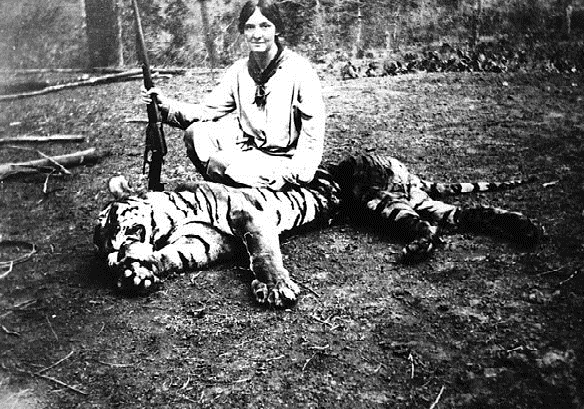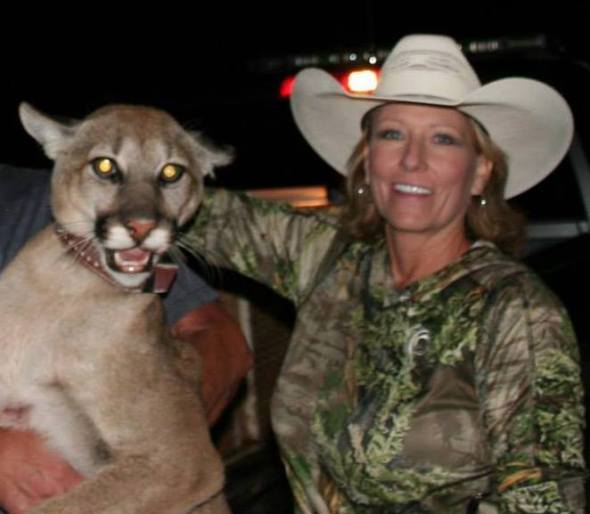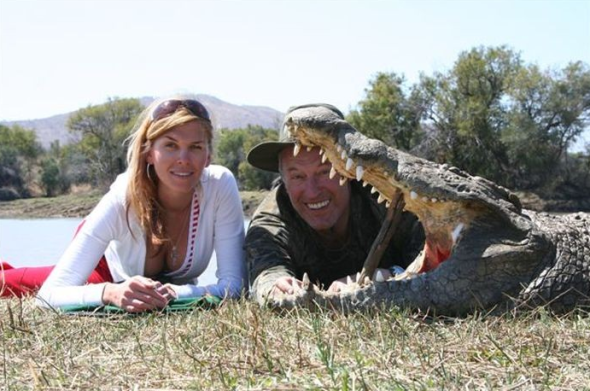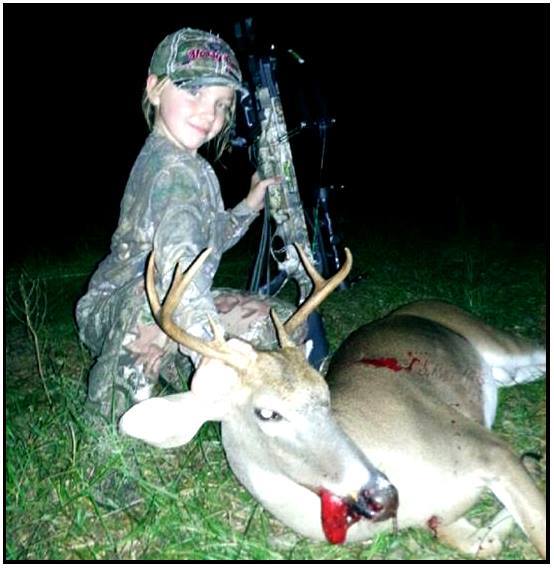Huntress Cry Victim.
BACK in February Environmental News and Media highlighted a brief article on hunting is not conservation of which basic facts were placed into the public domain debunking hunter gibber and how female hunters treat hunting as a type of fashion parade.
Uncle Sam’s Misguided Children, Daily Mail UK, The Sun, Telegraph, Colorado CBS Kathy Walsh and many more media and press stations published articles to the effect that we were in some way “bullying, stalking and harassing female hunters”.
I must say we was quite shocked to see many British animal and wildlife loving media and press actually supporting animal killers within the United States that hunt for the fun of it. Amusingly the comments left by some thousands on many media and press stations that were not in support of such acts of horrific animal abuse concluded our primary beliefs that women hunters are treating hunting as another form of porn gratification. Men on the other hand just get down with it as they have done for thousands of years just as sick and demented as their opposite sex. (Sorry not name calling there just pointing out basic common knowledge).
Both sexes have hunted animals internationally for thousands of years of which the majority of hunting was mostly to feed the family or supply animal bi-products to communities or family members. Problem is now hunting then has changed seeing a vast majority of hunter’s within the states now encroaching onto our Mama Africa in search of much larger and bigger prey to fulfil their adrenalin junkie punitive sensory organs. Charisa Argys states that it’s not a sexual lust – more a tradition passed down onto family members.
Keeping this article brief (for now) many hunters have been displaying concerns towards us that they feel we should not print on their activities being online and on the ground. We disagree there. Should a male hunter, female hunter or legal minor hunter wish to display acts of cowardly abuse online and via the ground to the hunting fraternity then we have every right to display too. After all we are speaking up for the dead animal. And its family!
Though hunting is now fairly well regulated by law, historically it was a chief cause of extinction in Southern Appalachia. The first to go were the large mammals. When Europeans first settled here in the late eighteenth century, for example, woodland bison were still plentiful. But hunters quickly learned to ambush them at natural salt licks, where the bison congregated. By 1800 they had become rare. Within a decade or two they were extinct.
Eastern elk, too, once inhabited the forests of Southern Appalachia. Like the woodland bison, the elk sought the salt licks, and, like the bison, there they were relentlessly slaughtered. They were extinct by the start of the Civil War. Elk recently reintroduced to the Smokies are not eastern elk but a non-native variety.

The Southern Appalachians were originally home to two kinds of wolves: the red and the grey. Both were hunters of deer, bison, and elk. As the settlers eliminated their prey, they turned increasingly to farm animals. The result was an escalating war of extermination that lasted until about 1920 when, somewhere deep in the Smokies, the last wolf cry was silenced. Though driven from the East and in constant retreat, grey wolves maintained substantial refuges away west in the Rockies, in Alaska, and in Canada. Wolf hunting continues to this very day and as usual it’s the wolf at blame. But the smaller red wolf, whose range never extended beyond the Southeast, was hunted almost to extinction. By the mid-1970s, there were maybe a hundred red wolves left in the world, mostly in Louisiana and Texas. Many of these could not find mates and had begun breeding with common coyotes, so that the strain was rapidly disappearing. During the 1990s attempts were made to reintroduce red wolves into the Smokies, but some of the wolves wandered repeatedly out of the Park;
Eastern Cougar some succumbed to parvo virus, probably caught from coyotes whose range had expanded to fill the niche left by the wolves; and some lapped up puddles of sweet-tasting antifreeze from parking lots and died in agony as ethylene glycol crystallized in their kidneys. As a result, reintroduction efforts were suspended, and the Smokies are once again empty of wolves.
Nobody knows when (or even if) the eastern cougar disappeared from the Southern Appalachians. Wary hunters, they were themselves hunted mercilessly for over two centuries. Sightings are still sometimes reported, but wildlife officials believe that if there are any big cats here they are released or escaped western cougars, not the native eastern variety.
Two remarkable Southern Appalachian birds, the passenger pigeon and the Carolina parakeet were hunted to extinction early in the 1900s. The Carolina parakeet, the only member of the parrot family native to the eastern United States, was a large and flamboyantly coloured bird, about thirteen inches long, mostly bright green, but with a yellow head and neck and orange cheeks and forehead. Carolina Parakeets were exterminated because they raided orchards, because ladies prized their feathers for hats, and because their bright colours made them useful for target practice.
The passenger pigeon may have been the most abundant bird species on earth. Ornithologists estimate their precolonial population at two to three billion. Their extensive winter roosting grounds along river bottoms in the Southern Appalachians are recalled in the names of two rivers, the Pigeon and the Little Pigeon, and in the name of the city of Pigeon Forge.
Despite their numbers, the passenger pigeons succumbed quickly. Market hunters across the eastern United States blasted hundreds of millions from their roosts or from the sky. The meat was shipped by rail to New York and Chicago, where it had become fashionable. Well before the passenger pigeons vanished, there were warning signs and scattered calls for conservation, but most people seemed to think that so numerous and familiar a bird could never be eliminated.
Their last precipitous decline surprised even the conservationists. As their numbers fell, the pigeons ceased to mate. Apparently their mating instinct was triggered in a way that we will now never understand by something in the presence of the great flock. The last known passenger pigeon, a female named Martha, died in the Cincinnati zoo in 1914.
These extinctions were warnings. Hunting was only the first great wave in the storm of extinction now sweeping the globe. Hunting targets larger animals, but today it is smaller animals and plants that are being lost, not to hunting, but to pollution, habitat destruction and competition from invasive organisms transported from distant ecosystems. These causes are harder to regulate, and as a result the pace of extinction is quickening.
Charisa states within Kathy Walsh’s CBS news article that she will continue her and here children’s rights to hunt no matter what. This is a woman after all that “lives in fear” a woman that went onto multinational media and press depicting her cougar hunt video to the dismay of thousands of angry commentaries that were gunning for her blood (yet gave her name and US state crying fear). Sorry Madame but we feel you actually adore the attention, rather that despise anti-hunters. The Daily Mail recently published an article of many on Giraffe hunters of which is titled “Is this really fun for all the family”. Daily Mail we are singling out here as being complete hypocritical bastard’s that wish to attack a well-known conservation welfare company in support of an American hunter yet hypocritically depict an article on US and EU hunters doing exactly what Charisa did?
What did the public think though of Madame Charisa hunting article that has most likely gained her respect and probably thousands in freebies to even an American Film.. Read below for more information;
Two weeks ago mum of two quoted;
How can she be proud of her “accomplishment” of shooting an animal that wasn’t threatening her? Had she fought off the animal barehanded in an attack and managed to kill it instead of it killing her, that would be an accomplishment. Shooting an animal merely for the fun of it with a high powered gun isn’t an accomplishment. At least deer hunters eat the meat. That poor cat died for no purpose other than for this woman to get some sort of sick pleasure in killing it.
OldFossil quotes;
The only time nature and animal populations get out of balance is when humans interfere in some way from introducing species to environments where they didn’t evolve or removing predators. How do these gun happy Yanks think the natural world managed to successfully evolve for billions of years before they came along with their bullets?
Rricco quotes;
She’s worried about those threatening comments but it’s okay for her to kill animals for fun. Wow…what a “smart” woman! ¿¿
Lynn from Canada quotes;
I have no problem with hunters that hunt for food not sport. Then taking a picture is equally sick.
In the 19th century, southern and central European sport hunters often pursued game only for a trophy, usually the head or pelt of an animal, which was then displayed as a sign of prowess. The rest of the animal was typically discarded. Some cultures, however, disapprove of such waste. In Nordic countries, hunting for trophies was—and still is—frowned upon. Hunting in North America in the 19th century was done primarily as a way to supplement food supplies, although it is now undertaken mainly for sport. The safari method of hunting was a development of sport hunting that saw elaborate travel in Africa, India and other places in pursuit of trophies. In modern times, trophy hunting persists and is a significant industry in some areas.
Trophy hunting is most often criticised when it involves rare or endangered animals. Opponents may also see trophy hunting as an issue of morality or animal cruelty, criticising the killing of living creatures for recreation. Victorian era dramatist W. S. Gilbert remarked, “Deer-stalking would be a very fine sport if only the deer had guns.”
There is also debate about the extent to which trophy hunting benefits the local economy. Hunters argue that fees paid contribute to the local economy and provide value to animals that would otherwise be seen as competition for grazing, livestock, and crops. This analysis is disputed by opponents of trophy hunting. Some argue that the animals are worth more to the community for ecotourism than hunting
Charisa goes on to quote that she will defend her child’s hunting career. (Picture above is not of her child of which we will not identify)..
Keeping this article informal and brief we will be printing a rebuttal soon, frankly the world must see now just how the female and male hunting groups are acting locally and internationally that hasn’t been displayed on the web. Charisa underestimates us stating that we obtained her picture without authorisation. Charisa provided her picture to our ENM journalist late last year of which has led us to other Colorado hunters and strangely animal abusers that get a kick out of killing and abusing animals for the sheer fun of it. ENM has been on the ground within the US since 2013 sourcing many US hunters both male and female. Watch this space as your likely to be in for a rather unpleasant shock.







